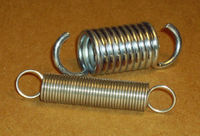
Photo from wikipedia
The energy balancing concept seeks to reduce actuation requirements for a morphing structure by strategically locating negative stiffness devices to tailor the required deployment forces and moments. One such device… Click to show full abstract
The energy balancing concept seeks to reduce actuation requirements for a morphing structure by strategically locating negative stiffness devices to tailor the required deployment forces and moments. One such device is the spiral pulley negative stiffness mechanism. This uses a cable connected with a pre-tension spring to convert the decreasing spring force into the increasing balanced torque. The kinematics of the spiral pulley is first developed for bidirectional actuation, and its geometry is then optimized by employing an energy conversion efficiency function. The performance of the optimized bidirectional spiral pulley is then evaluated through the net torque, the total required energy, and energy conversion efficiency. Then, an additional test rig tests the bidirectional negative stiffness property and compares the characteristics with the corresponding analytical result. Exploiting the negative stiffness mechanism is of significant interest not only in the field of morphing aircraft but also in many other energy and power reduction applications.
Journal Title: Journal of Mechanisms and Robotics
Year Published: 2019
Link to full text (if available)
Share on Social Media: Sign Up to like & get
recommendations!